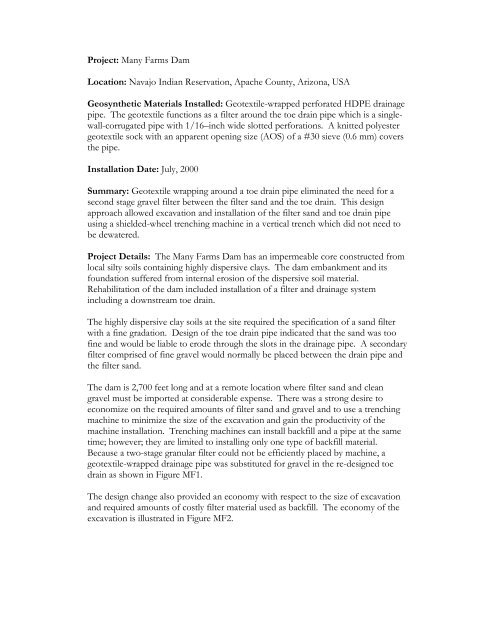Geotextiles in Embankment Dams - Association of State Dam Safety ...
Geotextiles in Embankment Dams - Association of State Dam Safety ...
Geotextiles in Embankment Dams - Association of State Dam Safety ...
Create successful ePaper yourself
Turn your PDF publications into a flip-book with our unique Google optimized e-Paper software.
Project: Many Farms <strong>Dam</strong>Location: Navajo Indian Reservation, Apache County, Arizona, USAGeosynthetic Materials Installed: Geotextile-wrapped perforated HDPE dra<strong>in</strong>agepipe. The geotextile functions as a filter around the toe dra<strong>in</strong> pipe which is a s<strong>in</strong>glewall-corrugatedpipe with 1/16–<strong>in</strong>ch wide slotted perforations. A knitted polyestergeotextile sock with an apparent open<strong>in</strong>g size (AOS) <strong>of</strong> a #30 sieve (0.6 mm) coversthe pipe.Installation Date: July, 2000Summary: Geotextile wrapp<strong>in</strong>g around a toe dra<strong>in</strong> pipe elim<strong>in</strong>ated the need for asecond stage gravel filter between the filter sand and the toe dra<strong>in</strong>. This designapproach allowed excavation and <strong>in</strong>stallation <strong>of</strong> the filter sand and toe dra<strong>in</strong> pipeus<strong>in</strong>g a shielded-wheel trench<strong>in</strong>g mach<strong>in</strong>e <strong>in</strong> a vertical trench which did not need tobe dewatered.Project Details: The Many Farms <strong>Dam</strong> has an impermeable core constructed fromlocal silty soils conta<strong>in</strong><strong>in</strong>g highly dispersive clays. The dam embankment and itsfoundation suffered from <strong>in</strong>ternal erosion <strong>of</strong> the dispersive soil material.Rehabilitation <strong>of</strong> the dam <strong>in</strong>cluded <strong>in</strong>stallation <strong>of</strong> a filter and dra<strong>in</strong>age system<strong>in</strong>clud<strong>in</strong>g a downstream toe dra<strong>in</strong>.The highly dispersive clay soils at the site required the specification <strong>of</strong> a sand filterwith a f<strong>in</strong>e gradation. Design <strong>of</strong> the toe dra<strong>in</strong> pipe <strong>in</strong>dicated that the sand was to<strong>of</strong><strong>in</strong>e and would be liable to erode through the slots <strong>in</strong> the dra<strong>in</strong>age pipe. A secondaryfilter comprised <strong>of</strong> f<strong>in</strong>e gravel would normally be placed between the dra<strong>in</strong> pipe andthe filter sand.The dam is 2,700 feet long and at a remote location where filter sand and cleangravel must be imported at considerable expense. There was a strong desire toeconomize on the required amounts <strong>of</strong> filter sand and gravel and to use a trench<strong>in</strong>gmach<strong>in</strong>e to m<strong>in</strong>imize the size <strong>of</strong> the excavation and ga<strong>in</strong> the productivity <strong>of</strong> themach<strong>in</strong>e <strong>in</strong>stallation. Trench<strong>in</strong>g mach<strong>in</strong>es can <strong>in</strong>stall backfill and a pipe at the sametime; however; they are limited to <strong>in</strong>stall<strong>in</strong>g only one type <strong>of</strong> backfill material.Because a two-stage granular filter could not be efficiently placed by mach<strong>in</strong>e, ageotextile-wrapped dra<strong>in</strong>age pipe was substituted for gravel <strong>in</strong> the re-designed toedra<strong>in</strong> as shown <strong>in</strong> Figure MF1.The design change also provided an economy with respect to the size <strong>of</strong> excavationand required amounts <strong>of</strong> costly filter material used as backfill. The economy <strong>of</strong> theexcavation is illustrated <strong>in</strong> Figure MF2.
















